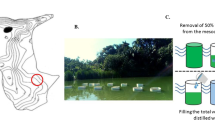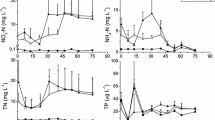Abstract
Eutrophication is a worldwide problem. In eutrophic lakes, phosphorus release from stored sediment hinders restoration processes. The epipelon is a community that grows attached to the sediment surface and has the potential to help phosphorus retention by autotrophic organisms. This study evaluated epipelon responses to four lake restoration techniques. The responses of abiotic variables and phytoplankton biomass were also evaluated. Four simultaneous mesocosm experiments were performed in a shallow eutrophic lake. The applied techniques were aeration, flocculant, floating macrophytes, and periphyton bioreactor. Water and epipelon samples were taken on days 3, 10, 17, 27, and 60. The aeration treatment and macrophytes decreased light availability in the epipelon, which had a predominance of heterotrophic components. Flocculant and periphyton bioreactor treatments favored epipelon growth with a higher contribution of autotrophic components. Therefore, some techniques may favor the epipelon growth, while others may harm the community, resulting in less efficient restoration processes. For the complete restoration of a lacustrine ecosystem, the choice of techniques to be applied must consider the restoration and maintenance of the benthic environment.






Similar content being viewed by others
Data availability
The datasets used and/or analyzed during the current study are available from the corresponding author upon reasonable request.
References
Amaral LM, Castilho MCA, Henry R, Ferragut C (2020) Epipelon, phytoplankton and zooplankton responses to the experimental oligotrophication in a eutrophic shallow reservoir. Environ Pollut 263:114603. https://doi.org/10.1016/j.envpol.2020.114603
APHA (2012) Standard methods for the examination of water and wastewater. American Public Health Association WWA, Washington, DC, ISBN-10 9780875530130
Barrado-Moreno MM, Beltrán-Heredia J, Martín-Gallardo J (2016) Removal of Oocystis algae from freshwater by means of tannin-based coagulant. J Appl Phycol 28:1589–1595. https://doi.org/10.1007/s10811-015-0718-y
Bicudo DC, Fonseca BM, Bini LM, Crossetti LO, Bicudo CEM, Araújo-Jesus T (2007) Undesirable side-effects of water hyacinth control in a shallow tropical reservoir. Freshw Biol 52:1120–1133. https://doi.org/10.1111/j.1365-2427.2007.01738.x
Bicudo DC, Zanon JE, Ferragut C, Crossetti LO, Faustino SB, Bicudo CEM (2020) Garças Reservoir trophic state dynamics: a 20-year synthesis. Hoehnea 47. https://doi.org/10.1590/2236-8906-72/2019
Borduqui M, Ferragut C (2012) Factors determining periphytic algae succession in a tropical hypereutrophic reservoir. Hydrobiologia 683(1):109–122. https://doi.org/10.1007/s10750-011-0943-6
Carneiro RO, Ferragut C (2022) Simulating oligotrophication in a eutrophic shallow lake to assess the effect of periphyton bioreactor on phytoplankton and epipelon. Environ Sci Pollut Res. https://doi.org/10.1007/s11356-022-23999-2
Craig N, Jones SE, Weidel BC, Solomon CT (2015) Habitat, not resource availability, limits consumer production in lake ecosystems. Limnol Oceanogr 60:2079–2089. https://doi.org/10.1002/lno.10153
Crossetti LO, Bicudo DC, Bini LM, Dala-Corte R B, Ferragut C, Bicudo CEM (2018) Phytoplankton species interactions and invasion by Ceratium furcoides are influenced by extreme drought and water-hyacinth removal in a shallow tropical reservoir. Hydrobiologia 1–15. https://doi.org/10.1007/s10750-018-3607-y
Dittrich M, Gabriel O, Rutzen C, Koschel R (2011) Lake restoration by hypolimnetic Ca(OH)2 treatment: Impact on phosphorus sedimentation and release from sediment. Sci Total Environ 409:1504–1515. https://doi.org/10.1016/j.scitotenv.2011.01.006
Dodds WK (2003) The role of periphyton in phosphorus retention in shallow freshwater aquatic systems. J Phycol 39:840–849. https://doi.org/10.1046/j.1529-8817.2003.02081.x
Downing JA, Prairie YT, Cole JJ, Duarte CM, Tranvik LJ, Striegl RG, McDowell WH, Kortelainen P, Caraco NF, Melack JM, Middelburg JJ (2006) The global abundance and size distribution of lakes, ponds, and impoundments. Limnol Oceanogr 51(5):2388–2397. https://doi.org/10.4319/lo.2006.51.5.2388
Fonseca BM, Ferragut C, Tucci A, Crosseti LO, Ferrari F, Bicudo DC, Sant’Anna CL, Bicudo CEM (2014) Biovolume de cianobactérias e algas de reservatórios tropicais do Brasil com diferentes estados tróficos. Hoehnea 41:9–30. https://doi.org/10.1590/S2236-89062014000100002
Gamage NPD, Asaeda T (2005) Decomposition and mineralization of Eichhornia crassipes litter under aerobic conditions with and without bacteria. Hydrobiologia 541:13–27. https://doi.org/10.1007/s10750-004-4663-z
Genkai-Kato M, Vadeboncoeur Y, Liboriussen L, Jeppesen E (2012) Benthic-planktonic coupling, regime shifts, and whole-lake primary production in shallow lakes. Ecology 93(3):619–631. https://doi.org/10.1890/10-2126.1
Gerling AB, Browne RG, Gantzer PA, Mobley MH, Little JC, Carey CC (2014) First report of the successful operation of a side stream supersaturation hypolimnetic oxygenation system in a eutrophic, shallow reservoir. Water Res 67:129–143. https://doi.org/10.1016/j.watres.2014.09.002
Grochowska J, Augustyniak R, Łopata M (2017) How durable is the improvement of environmental conditions in a lake after the termination of restoration treatments. Ecol Eng 104:23–29. https://doi.org/10.1016/j.ecoleng.2017.03.020
Hao B, Roejkjaer AF, Wu H, Cao Y, Jeppensen E, Li W (2018) Responses of primary producers in shallow lakes to elevated temperature: a mesocosm experiment during the growing season of Potamogeton crispus. Aquat Sci 80:34. https://doi.org/10.1007/s00027-018-0585-0
He H, Luo X, Jin H, Gu J, Jeppesen E, Liu Z, Li K (2017) Effects of exposed artificial substrate on the competition between phytoplankton and benthic algae: Implications for shallow lake restoration. Water 9(1):24. https://doi.org/10.3390/w9010024
Hillebrand H, Durselen CD, Kirschtel D, Pollingher U, Zohary T (1999) Biovolume calculation for pelagic and benthic microalgae. J Phycol 35:403–424. https://doi.org/10.1046/j.1529-8817.1999.3520403.x
Hou J, Yang Z, Wang P, Wang C, Yang Y, Wang X (2018) Changes in Microcystis aeruginosa cell integrity and variation in microcystin-LR and proteins during Tanfloc flocculation and floc storage. Sci Total Environ 626:264–273. https://doi.org/10.1016/j.scitotenv.2018.01.074
Janssen ABG, Wijk D, Gerven LPA, Bakker ES, Brederveld RJ, DeAngelis DL, Janse JH, Mooij WM (2019) Success of lake restoration depends on spatial aspects of nutrient loading and hydrology. Sci Total Environ 679:248–259. https://doi.org/10.1016/j.scitotenv.2019.04.443
Jeppesen E, Søndergaard M, Jensen JP, Havens KE, Anneville O, Carvalho L, Coveney MF, Deneke R, Dokulil MT, Foy B, Gerdeaux D, Hampton SE, Hilt S, Kangur K, Köhler J, Lammens EH, Lauridsen TL, Manca M, Miracle MR, Moss B, Nõges P, Persson G, Phillips G, Portielje R, Romo S, Schelske CL, Straile D, Tatrai I, Willén E, Winder M (2005) Lake responses to reduced nutrient loading – an analysis of contemporary long-term data from 35 case studies. Freshwat Biol 50:1747–1771. https://doi.org/10.1111/j.1365-2427.2005.01415.x
Jeppesen E, Meerhoff M, Jacobsen BA, Hansen RS, Søndergaard M, Jensen JP, Lauridsen TL, Mazzeo N, Branco CWC (2007) Restoration of shallow lakes by nutriente control and biomanipulation - the successful strategy varies with lake size and climate. Hydrobiologia 581(1):269–285. https://doi.org/10.1007/s10750-006-0507-3
Ko S, Srivastava A, Lee N, Jin L, Oh H, Ahn C (2019) Bioremediation of eutrophic water and control of cyanobacterial bloom by attached periphyton. Int J Environ Sci Technol 16(8):4173–4180. https://doi.org/10.1007/s13762-019-02320-8
Lamparelli MC (2004) Graus de trofia em corpos d’água do estado de São Paulo: avaliação dos métodos de monitoramento [Trophic Status in São Paulo State Water Bodies Evaluation of Monitoring Methodologies] Thesis (Doctoral) Universidade de São Paulo (USP). Available from: http://www.teses.usp.br/teses/disponiveis/41/41134/tde-20032006-075813/pt-br.php (accessed March 2023)
Latour D, Sabido O, Salençon MJ, Giraudet H (2004) Dynamics and metabolic activity of the benthic cyanobacterium Microcystis aeruginosa in the Grangent reservoir (France). J. Plankton Res 26(7):719–726. https://doi.org/10.1093/plankt/fbh075
Liboriussen L, Jeppesen E (2006) Structure, biomass, production and depth distribution of periphyton on artificial substratum in shallow lakes with contrasting nutrient concentrations. Freshw Biol 51:95–109. https://doi.org/10.1111/j.1365-2427.2005.01481.x
Mayr M, Jerney J, Schagerl M (2014) Combating planktonic algae with benthic algae. Ecol Eng 74:310–318. https://doi.org/10.1016/j.ecoleng.2014.10.034
Moal ML, Gascuel-Odoux C, Ménesguen A, Souchon Y, Étrillard C, Levain C, Moatar F, Pannard A, Souchu P, Lefebvre A, Pinay G (2019) Eutrophication: A new wine in an old bottle? Sci Total Environ 651:1–11. https://doi.org/10.1016/j.scitotenv.2018.09.139
Moss B (1990) Engineering and biological approaches to the restoration from eutrophication of shallow lakes in which aquatic plant communities are important components. Hydrobiologia 200(1):367–377. https://doi.org/10.1007/BF02530354
Nygrén NA, Tapio P, Horppila J (2017) Will the oxygen-phosphorus paradigm persist? – Expert views of the future of management and restoration of eutrophic lakes. Environ Manag 60:947–960. https://doi.org/10.1007/s00267-017-0919-z
Pan G, Yang B, Wang D, Chen H, Tian B, Zhang M, Yuan X, Chen J (2011) In-lake algal bloom removal and submerged vegetation restoration using modified local soils. Ecol Eng 37(2):302–308. https://doi.org/10.1016/j.ecoleng.2010.11.019
Sartory DP, Grobbelaar JU (1984) Extraction of chlorophyll a from freshwater phytoplankton for spectrophotometric analysis. Hydrobiologia 114:177–187. https://doi.org/10.1007/BF00031869
Scheffer M, Carpenter S, Foley JA, Folke C, Walker B (2001) Catastrophic shifts in ecosystems. Nature 413:591–596. https://doi.org/10.1038/35098000
Schindler DW, Carpenter SR, Chapra SC, Hecky RE, Orihel DM (2016) Reducing phosphorus to curb lake eutrophication is a success. Environ Sci Techno 50(17):8923–8929. https://doi.org/10.1021/acs.est.6b02204
Simon M, Joshi H (2021) A review on green technologies for the rejuvenation of polluted surface water bodies: Field-scale feasibility, challenges, and future perspectives. J Environ Chem Eng 9:105763. https://doi.org/10.1016/j.jece.2021.105763
Søndergaard M, Jensen JP, Jeppesen E (2003) Role of sediment and internal loading of phosphorus in shallow lakes. Hydrobiologia 506(1-3):135–145. https://doi.org/10.1023/B:HYDR.0000008611.12704.dd
Søndergaard M, Jeppesen E, Lauridsen TL, Skov C, Van Nes EH, Roijackers R, Lammens E, Portielje R (2007) Lake restoration: successes, failures and long-term effects. J Appl Ecol 44:1095–1105. https://doi.org/10.1111/j.1365-2664.2007.01363.x
Thamaga KH, Dube T (2018) Remote sensing of invasive water hyacinth (Eichhornia crassipes): A review on applications and challenges. Remote Sens Appl: Soc Environ 10:36–46. https://doi.org/10.1016/j.rsase.2018.02.005
Thomaz SM, Bini M (2003) Ecologia e manejo de macrófitas aquáticas, editores. EDUEM, Maringá, ISBN 978-85-7628-191-7
Wang Z, Zhang Z, Zhang Y, Zhang J, Yan S, Guo J (2013) Nitrogen removal from Lake Caohai, a typical ultra-eutrophic lake in China with large scale confined growth of Eichhornia crassipes. Chemosphere 92(2):177–183. https://doi.org/10.1016/j.chemosphere.2013.03.014
Wetzel RG (1983) Periphyton of freshwater ecosystems. Dr. W. Junk, The Hague, ISBN: 978-94-009-7293-3
Wetzel RG, Likens GE (1991) Limnological Analysis, 2nd Edition. Springer Verlag, New York
Yan SH, Song W, Guo JG (2016) Advances in management and utilization of invasive water hyacinth (Eichhornia crassipes) in aquatic ecosystems – a review. Crit Rev Biotechnol 37(2):218–228. https://doi.org/10.3109/07388551.2015.1132406
Zhang S, Zhou Q, Xu D, Lin J, Cheng S, Wu Z (2010) Effects of sediment dredging on water quality and zooplankton community structure in a shallow of eutrophic lake. J Environ Sci 22(2):218–224. https://doi.org/10.1016/S1001-0742(09)60096-6
Zhang X, Mei X, Gulati RD, Liu Z (2015) Effects of N and P enrichment on competition between phytoplankton and benthic algae in shallow lakes: a mesocosm study. Environ Sci Pollut Res 22:4418–4424. https://doi.org/10.1007/s11356-014-3680-3
Acknowledgements
The authors are grateful for the financial support of the Fundação de Amparo à Pesquisa do Estado de São Paulo (FAPESP 2017/50341–0) and doctoral scholarship for RAC (FAPESP 2018/26686-0). The authors are grateful to the students and technicians involved in laboratory work and the field. We also thank the company Tanac for supplying the flocculant.
Author contributions
RAC and CF carried out the experimental design, the field experiment, sampling, and laboratory analysis and wrote the manuscript.
Funding
This study was financially supported by FAPESP (Fundação de Amparo à Pesquisa do Estado de São Paulo) (2017/50341–0; 2018/26686-0).
Author information
Authors and Affiliations
Corresponding author
Ethics declarations
Conflict of interest
The authors declare no competing interests.
Rights and permissions
Springer Nature or its licensor (e.g. a society or other partner) holds exclusive rights to this article under a publishing agreement with the author(s) or other rightsholder(s); author self-archiving of the accepted manuscript version of this article is solely governed by the terms of such publishing agreement and applicable law.
About this article
Cite this article
Costa, R.A., Ferragut, C. Epipelon biomass responses to different restoration techniques in a eutrophic environment. Environmental Management 72, 505–518 (2023). https://doi.org/10.1007/s00267-023-01811-2
Received:
Accepted:
Published:
Issue Date:
DOI: https://doi.org/10.1007/s00267-023-01811-2




